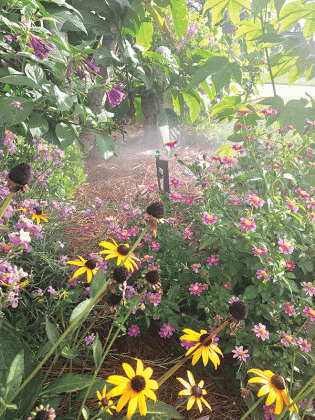
Heather Kirk-Ballard / LSU AgCenter horticulturist
As the scorching summer sun takes center stage, it’s not just us that feel the heat. Our leafy friends also need some extra TLC during these sweltering months. High temperatures, intense sunlight and dry conditions can take a toll on their health and vitality.
With a little care and attention, you can help your plants beat the heat and thrive throughout the summer. Here are some tips that will keep your plants cool, healthy and vibrant during the hottest time of the year.
When plants are stressed by excessive heat and do not receive adequate water, several negative effects can occur, ultimately impacting their overall health and survival. It is important to know the signs and symptoms of heat stress and water deficiency in plants.
One of the initial signs of plant stress is wilting. When plants lack sufficient water, they are unable to maintain turgor pressure (internal water-induced cell pressure), causing their leaves and stems to droop and wilt. This wilted appearance is a result of the plant’s attempt to conserve water by reducing the surface area exposed to the sun.
Prolonged heat stress and water scarcity can cause leaves to turn brown or yellow or develop scorched edges because the plant cannot maintain sufficient hydration and struggles to transport water and nutrients to its leaves. As a result, the leaves may become dry, brittle and ultimately die off.
Plants can exhibit stunted growth when they are heat stressed or lack water. Water is essential for various metabolic processes within plants, including photosynthesis, nutrient absorption and growth. Plants may exhibit reduced leaf and stem growth, limiting their size. This can also reduce, delay or prevent flowering. Similarly, fruit production may be limited, resulting in smaller or fewer fruits or those that drop prematurely.
Stressed plants have increased susceptibility to pests and disease. When plants lack water, their natural defense mechanisms weaken, making them more vulnerable to attacks from insects, fungi and other pathogens. This weakened state makes it harder for the plant to recover and fight off these invaders. Without sufficient water, the plant’s vital functions and physiological processes become compromised and can cause irreversible damage to its tissues and systems.
To prevent or minimize the negative effects of heat stress and water deficiency, it is crucial to provide adequate water, shade and care for plants during hot summer months.
You must water wisely. The key to watering is finding the right balance, ensuring that you provide enough water to keep the soil consistently moist while avoiding overwatering, which can lead to root rot. Water your plants deeply and early in the morning or late in the evening when the temperature is cooler, allowing the roots to absorb moisture effectively. Consider using a drip irrigation system or a soaker hose to provide a slow, steady supply of water directly to the roots.
Mulching is a simple yet highly effective technique to keep plants cool and conserve moisture. Apply a layer of organic mulch such as shredded bark, leaves or compost around the base of your plants. This acts as a protective barrier, reducing soil evaporation and preventing weed growth. Mulch also helps regulate soil temperature, keeping it cooler during the hot summer days. Aim for a thickness of 2 to 4 inches. Be careful not to pile it against the plant stems to avoid rot.
Just as we seek shade on a scorching day, plants can benefit from some respite too. If possible, provide shade to delicate plants by using umbrellas, shade cloths or even setting up temporary structures to shield them from the direct rays of the sun during the hottest parts of the day.
Just like a cool shower rejuvenates us, a refreshing mist or spray can work wonders for your plants. Consider misting the foliage of your plants using a fine spray nozzle. The evaporating water will increase humidity and provide a microclimate around your green companions. Be cautious not to mist during the hottest part of the day, as it can potentially lead to sunburn on wet leaves.
With these tips in your gardening arsenal, you can ensure your plants not only survive but thrive during the dog days of summer. By watering wisely, mulching effectively, providing shade and offering a refreshing mist, you can keep your plant companions healthy throughout the hot weather.
